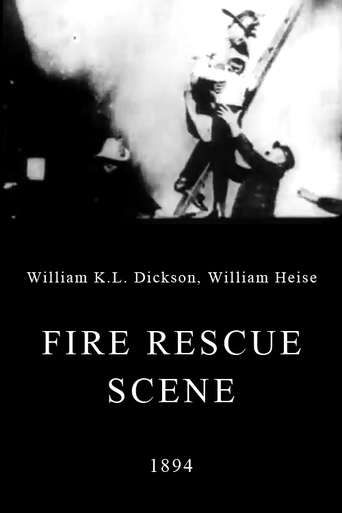

The Edison team of William Heise and W.K.L. Dickson work together to create this short film. It features a firemn, standing on a ladder, rescuing children from a burning building. He hands the children to another fireman, while smoke twirls around them.Various firefighting themes where very popular during the beginnings of film. From staged runs of fire trucks to short scenes of firemen rescuing victims, people from the turn-of-the-century loved watching anything to do with firefighting. Heise would go on to film other firefighting movies, such as "The Morning Alarm".I give it a 2 out of 10 as an important early short film.
... View MoreThe title says it all already what this short film is about. The house is burning, smoke is everywhere and a fireman climbs up a ladder to get a woman out. He carries her, hands her forward to another one waiting downstairs and she is in safety. Is all good now? Not really. Her little child is also still caught in the flames, but rescue is near. The execution is done very convincingly in this one. It's totally clear what happens in these 30 seconds and this can certainly not be said about every movie shot during that very early period of filmmaking. Good effort from silent film dream team Dickson and Heise here and one to watch for admirers of the early days of cinema.
... View More. . . as their fire department takes another day off to pose for Thomas Edison's cameras. Many New York City area landmarks (including the Durland Academy) bit the dust as soon as Edison began monopolizing the time of the local Hosemen to "fight" fake fires in his film studios, and to stage miles-long bogus fire runs into the middle of nowhere so old Tom could still have his "film at 11," as the expression goes. Though only four sworn protectors of the public appear in camera frame during FIRE RESCUE SCENE, their uniforms indicate that these guys are from FOUR DIFFERENT FIRE DEPARTMENTS, the remainders of which are no doubt watching Nero--oops, I mean Edison--fiddle as Rome, NY, along with the rest of the southeastern Empire State, plus probably parts of Jersey and Connecticut, burn.
... View MoreFootage of fire-fighters in action quickly became one of the popular genres of 1890s motion pictures, and this very short feature is one of the very earliest examples. Unlike most of the later movies of similar subjects, it was filmed in the studio rather than outdoors. Yet it is still successful for its time in conveying the inherent sense of danger and urgency that made the fire-fighting genre popular to begin with.The footage of "Fire Rescue Scene" consists of a staged enactment of a typical rescue operation, most likely using real professional fire-fighters, in which one of the fire-fighters uses a ladder to reach residents trapped in a burning building. By using children as the endangered residents, it adds extra tension and suspense. The then-standard 50 foot length of film limits how much can happen, but it fills almost the entire running time with action.It must have been both difficult and hazardous to stage such a scene inside Edison's 'Black Maria' studio, but they were able to pull it off. The thick smoke is effective, and only the lack of any background detail limits the realism.It was not long before film-makers realized that outdoor photography worked better for features like this, and soon many movies would be made of live fire-fighting scenes as well as staged enactments, with almost all of them being filmed outside of a studio. This pioneering effort, though, is quite creditable for its time.
... View More